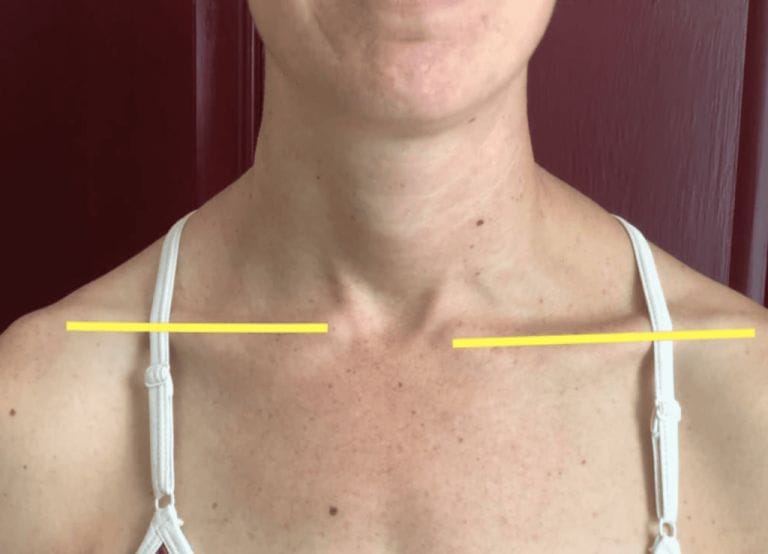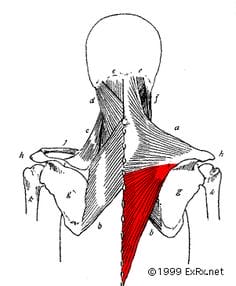Do your neck and shoulders feel tight? Does your ‘knot gremlin‘ have a name? Are you constantly looking for or getting a massage for your neck and/or shoulders?
You are certainly not alone. I used to suffer from constant neck/upper shoulder (your upper trap area) tightness and no matter how many massages I had or how much tiger balm I rubbed on those muscles it never really seemed to go away.

By Anatomography – en:Anatomography (setting page of this image)., CC BY-SA 2.1 jp, Link
The answer to why you may be experiencing this discomfort could be your collarbones–the position of your collarbones, that is.
Go find a mirror, take a look at your collarbones–you may need to take your shirt off.
Do they look flat like this?

That’s me demonstrating flat collarbones (and that I am a bit lopsided due to life, a little scoliosis and probably muscle stiffness somewhere…but all of that is beside the point).
This position is reflective of shoulder blades that are relatively depressed (‘down and back’, anyone?), which makes the upper traps (and some other neck muscles) a bit stretched out.
In this position, my neck and shoulder muscles feel ‘tight’, but that tension they’re feeling isn’t tension from muscles in a shortened position, it’s tension from overstretched muscles just trying to hold my arms and shoulders on my body.
For years, I had poor posture…and then when I started trying to correct my poor posture, I followed the cue of shoulders back and down while trying to stand up tall. Each cue has a time and place, but when you try to do that all the time…throw some weak muscles into the mix (which may have been partially due to this battle between my “poor posture” and my efforts to “correct” it to a position I thought was correct) and it was a great recipe for neck pain.
As I said, I spent years like this until I was in PT for bicep impingement due to a flying trapeze training incident. Because proper strength training is the best way to make sure the PT process helps you to recover from an injury and come out even stronger on the other side, I sought out one of the best overhead specialists in the business to help me. That’s where I learned my shoulders were too depressed and part of the reason for my injury.
The amazing thing was once I got my shoulder blades and collarbones where they belong and strengthened the muscles to keep them there, my neck pain went away. That’s not to say that I don’t every once in a while have a crick in my neck due to sleeping weird, but daily neck tension is a thing of the past.
I hope that this post may be of help for you. Flat collarbones and depressed shoulder blades may not be the reason for your neck discomfort, but if you notice that you have flat collarbones, then this post could help.
Angry Eyebrows
That’s what I call the shape you want your collarbones making. (From the medial end of your collarbones to the outer, lateral end, we’re looking for a 6 to 20 degree upslope). I know for me in the beginning I felt like I was shrugging my shoulders up all the time. Eventually with practice and training, it became more natural.

What Flat Collarbones Say
Aside from overstretched upper traps, this depressed position also suggests your shoulder blades aren’t going to be upwardly rotating as well as they could when you bring your arms overhead. This can be problematic, especially when you’re hanging from a bar or if you happen to be hanging upside down and holding another person.
Because your shoulder blades are starting from a relatively downwardly rotated position, it makes it challenging for them to upwardly rotate enough when you raise your arms overhead. This can lead to impingement pain.
The win here is that working on improving the position of your collarbones (by reducing the amount of shoulder blade depression at rest) will not only help your neck feel less tension, but also help to improve your (scapular) upward rotation which will improve your overhead range of motion in your shoulders. And who isn’t excited about that!?!
3 exercises to achieve angry eyebrow collarbones
These are far from the only exercises that will help here, but they are a good place to start. Bear in mind, this is a process that takes some time–especially since it can be difficult at first to really feel the muscles.
I know for me, now 5+ years ago, when I started, I found these exercises, hard and even a little frustrating. It wasn’t until months later that I saw the beauty in them and the added benefit of no longer having neck pain. And then came the day that my angry eyebrow posture had become the norm and something I no longer needed to actively think about. Oh, what practice does…
So without further ado:
- All fours breathing
Key points: Find a ‘cat’ shape from yoga cat-cow pose by pushing the floor away from you with your hands. Inhale into your upper back. Feel your shoulder blades wrap forward around your sides a little. Exhale all the air out through pursed lips. Do 5-8 breath cycles. Bonus upward rotation note: set hands slightly forward of shoulder to promote more upward rotation as you press into the floor with your hands and curl your spine.
- Serratus wall slides with a foam roller
Key points: Exhale press into the foam roller as you reach up feeling the shoulder blades go up and hug around your sides. Make sure your elbows don’t get all the way straight, it’s important to maintain a little bend in them. Find that ‘cat’ pose feeling, exhaling fully. Do 8-10 reps.
- One-arm trap raise
Key points: Start without a weight (this video shows the exercise with a weight). A weight is a great way to progress, but start without one to make sure you’re activating the correct muscles first. Do 6-8 reps each side.
How to:
- Set up in all fours with your hips stacked over your knees, toes tucked under (which is not how I demoed it in this video–tsk tsk) and shoulders over hands.
- Engage core to stabilize your spine. As you raise the arm you need your core engaged to make sure that side doesn’t tip down or up.
- Actively press into the floor through the opposite shoulder and hand to stabilize your shoulder.
- On an exhale, slide the arm out along the floor–reaching far away the whole time. I tell people think of yourself as Elastigirl. Or Go, Go, Gadget Arms!
- Continue to exhale as you reach far while you lift the arm off the floor.
- You want to be reaching and lifting in a Y pattern.
- Inhale, lower the arm to the floor and slide it back in under the shoulder.
- **If you have to bend your raising arm to get it back in under your torso then you know that you sunk down in the opposite shoulder or tilted your torso towards the ground. Neither is correct. Press harder through the opposite shoulder and hand and keep core contracted to ensure the spine and shoulders don’t twist or tilt.**

- You want to feel this in your lower trap. Your upper trap is doing a little work, but shouldn’t be the prime mover here. The lower trap is one of the muscles contracting to produce upward rotation. You want to feel some activation in your middle/lower middle back.
Here’s to less neck pain and improved range of motion in your shoulders!
Happy training! ~Theresa


Pingback: Friday Five for November 8, 2019 – Circus Mobility LLC
Pingback: Moving out of Pain (Part 1) - Reimagym
Pingback: Tight Calves? Try This. - Reimagym